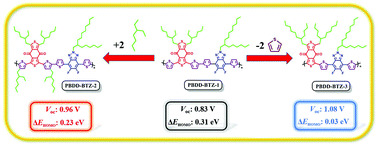Double acceptor block-based copolymers for efficient organic solar cells: side-chain and π-bridge engineered high open-circuit voltage and small driving force†
Abstract
Different from the traditional concept of donor–acceptor (D–A) structures, the newly reported design strategy of acceptor1–acceptor2 (A1–A2) type copolymers has been regarded as an efficient approach to boost the open circuit voltage (Voc) of organic solar cells (OSCs). Herein, three A1–A2 type copolymers PBDD-BTZ-1, PBDD-BTZ-2 and PBDD-BTZ-3 with a 1,3-bis(thiophen-2-yl)-5,7-bis(2-ethylhexyl)benzo-[1,2-c:4,5-c′]dithiophene-4,8-dione (BDD) derivative as the A1 unit and fluorine substituted benzotriazole (FTAZ) as the A2 unit are prepared for OSCs. Subtle modification on the side chain and π-bridge is found to cause a big difference on the photoelectric properties and the resulting device performance of these new double A copolymers. A deep HOMO level of −5.63 eV with an extremely small driving force of 0.06 eV is found to be obtained by the PBDD-BTZ-3 copolymer. As a result, an impressive Voc of 1.09 eV is obtained when it was blended with an ITIC-Th acceptor. On the other hand, the best device performance is achieved by the PBDD-BTZ-2 copolymer among these copolymers, due to its most favorable morphology. These results suggest that A1–A2 type copolymers can enrich the types of donor materials and will open a new possibility for developing efficient copolymers to boost the Voc of OSCs with a small driving force by reasonable combination of different electron-deficient blocks.



 Please wait while we load your content...
Please wait while we load your content...